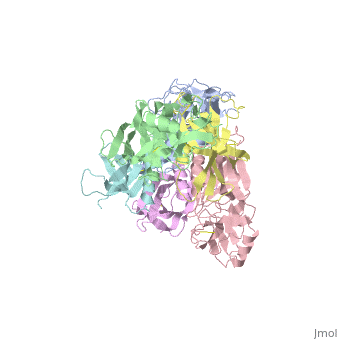1prt
From Proteopedia
THE CRYSTAL STRUCTURE OF PERTUSSIS TOXIN
Structural highlights
FunctionTOX1_BORPE S1 is an NAD-dependent ADP-ribosyltransferase, which plays a crucial role in the pathogenesis of B.pertussis causing disruption of normal host cellular regulation. It catalyzes the ADP-ribosylation of a cysteine in the alpha subunit of host heterotrimeric G proteins. In the absence of G proteins it also catalyzes the cleavage of NAD(+) into ADP-ribose and nicotinamide. It irreversibly uncouples the G-alpha GTP-binding proteins from their membrane receptors. Evolutionary ConservationCheck, as determined by ConSurfDB. You may read the explanation of the method and the full data available from ConSurf. Publication Abstract from PubMedBACKGROUND: Pertussis toxin is an exotoxin of the A-B class produced by Bordetella pertussis. The holotoxin comprises 952 residues forming six subunits (five different sequences, S1-S5). It plays an important role in the development of protective immunity to whooping cough, and is an essential component of new acellular vaccines. It is also widely used as a biochemical tool to ADP-ribosylate GTP-binding proteins in the study of signal transduction. RESULTS: The crystal structure of pertussis toxin has been determined at 2.9 A resolution. The catalytic A-subunit (S1) shares structural homology with other ADP-ribosylating bacterial toxins, although differences in the carboxy-terminal portion explain its unique activation mechanism. Despite its heterogeneous subunit composition, the structure of the cell-binding B-oligomer (S2, S3, two copies of S4, and S5) resembles the symmetrical B-pentamers of the cholera toxin and Shiga toxin families, but it interacts differently with the A-subunit. The structural similarity is all the more surprising given that there is almost no sequence homology between B-subunits of the different toxins. Two peripheral domains that are unique to the pertussis toxin B-oligomer show unexpected structural homology with a calcium-dependent eukaryotic lectin, and reveal possible receptor-binding sites. CONCLUSION: The structure provides insight into the pathogenic mechanisms of pertussis toxin and the evolution of bacterial toxins. Knowledge of the tertiary structure of the active site forms a rational basis for elimination of catalytic activity in recombinant molecules for vaccine use. The crystal structure of pertussis toxin.,Stein PE, Boodhoo A, Armstrong GD, Cockle SA, Klein MH, Read RJ Structure. 1994 Jan 15;2(1):45-57. PMID:8075982[1] From MEDLINE®/PubMed®, a database of the U.S. National Library of Medicine. See AlsoReferences
| ||||||||||||||||||


